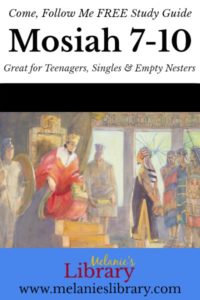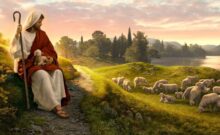Come, Follow Me Daily Study Guide for the week of October 26-November 1, 2020 covering Mormon 1-6. For personal and/or family study of the scriptures, geared towards families with teenagers, single adults, and empty nesters.

*This is a suggested outline that coincides with the Come, Follow Me manual. There is not just one right way when it comes to studying the scriptures. Everyone should study in a way that is best for them, but I do hope that you find these outlines helpful.
**I highly suggest getting a scripture journal. Throughout the year there will be several times that I will suggest jotting something down in your scripture journal. These are also great for writing down any impressions or “Aha” moments that you might have as you study the scriptures.
***A free PDF DOWNLOAD of the Study Guide is available at the bottom of this post, making it easy for those who’d like to print out a copy. OR you can add Melanie’s Library to your mobile device home screen by following these instructions, click HERE
****SONGS – For a list of suggested songs for each day of the week, be sure and check out the blog called Music for Latter-day Life by clicking HERE

FHE DAY
Start the week off right with a Family Home Evening that is focused around the upcoming week’s Come, Follow Me. Sign up for the Teach Me FHE email group and receive an FHE outline delivered right to your inbox every Sunday morning. Sign up at the bottom of this post.

GODLY SORROW LEADS TO TRUE AND LASTING CHANGE
BACKGROUND/SCRIPTURE
Mormon at the young age of 16 led the Nephites into battle against the Lamanites. It was a horrific battle with much blood and carnage sweeping the land.
SHOW IMAGE

Image used for educational purposes
The Nephites became very sorrowful. Mormon had hoped that their sorrow would lead them to cry unto God for repentance. The Nephites did cry unto God but not for what Mormon had hoped.
READ: Mormon 2: 10-15
“Their sorrowing was not unto repentance” (vs 13)—it was not the kind of godly sorrow that leads to real change. Instead, the Nephites felt worldly sorrow.
MINI LESSON
OBJECT LESSON: (Taken from Scripture Study for Latter-day Saint Families)
Take a small branch from a tree or bush and show your family how flexible it is. Place a bowl filled with mud near the branch. Bend the branch so the leaves touch the mud and become filthy. Ask your family what they would do to clean the leaves. Remind your family that when this little branch is planted outside in the elements, a strong wind could bend it to the ground causing its leaves to become filthy again.
ASK:
- If all you do is spray the mud off the leaves each time the wind blows, do we solve the problem?
- What might help keep this branch from bending so much in the wind? (Stake the tree in several places to provide support)
- How can we compare this to a person who sins?
- Can merely washing off one’s sins be enough? Or do they need to make changes in their life to ensure that they do not keep committing the same sin?
QUOTE BY PRESIDENT SPENCER W. KIMBALL:
“Very frequently people think they have repented and are worthy of forgiveness when all they have done is to express sorrow or regret at the unfortunate happening, but their repentance is barely started. Until they have begun to make changes in their lives, transformation in their habits, and to add new thoughts to their minds, to be sorry is only a bare beginning.” (“What is True Repentance?” New Era, January 1996)
ACTIVITY: (Taken from CFM manual)
To understand the difference between godly sorrow and worldly sorrow, make a chart in your scripture journals. Refer to the scripture verses that you read (Mormon 2:10–15) and record what you learned about these two types of sorrow. Your chart might look something like this:
GODLY SORROW WORDLY SORROW
Comes to Jesus (vs 14) Curses God (vs 14)
PONDER & DISCUSSAs you reflect on what you learn, consider how it can influence your efforts to overcome sin and become more like Heavenly Father and the Savior.
In verse 15, what do you think “the day of grace was passed” means?
QUOTE BY PRESIDENT HAROLD B. LEE:
“One of the greatest principles of the gospel of Jesus Christ is the principle of repentance. However, if one has sinned so seriously and becomes habitually a sinner, the spirit of repentance leaves, and he may or may not be able to repent.” (Church News, March 3, 1973)
VIDEO: Why Doesn’t God Punish Us the Moment We Sin? (1:59), click HERE
ADDITIONAL RESOURCES (optional)
CONFERENCE TALK: You Can Do It Now! By President Dieter F. Uchtdorf
CONFERENCE PARABLE: Hallstrom Family Recipe
OLD CHURCH VIDEO: Godly Sorrow Leads to Repentance (1992)
QUOTE BY DALLIN H. OAKS: “Repentance, which is an assured passage to an eternal destination, is nevertheless not a free ride….Why is it necessary for us to suffer on the way to repentance for serious transgressions? We often think of the results of repentance as simply cleansing us from sin. But that is an incomplete view of the matter. A person who sins is like a tree that bends easily in the wind. On a windy and rainy day the tree bent so deeply against the ground that the leaves became soiled with mud, like sin. If we only focus on cleaning the leaves, the weakness in the tree that allowed it to bend and soil its leaves may remain. Merely cleaning the leaves does not strengthen the tree in the next high wind. The susceptibility to repetition continues until the tree has been strengthened.”

I SHOULD ALWAYS ACKNOWLEDGE GOD’S HAND IN MY LIFE
BACKGROUND
(Adapted from Scripture Study for Latter-day Saint Families)
SHOW THE FOLLOWING IMAGES:
PICTURE #1

PICTURE #2

PICTURE #1: A vase or two faces?
PICTURES #2: An old woman or a young woman?
- As you looked at each picture, what did you see first?
- How long did it take you to see the other perspective?
- What causes some people to see things differently from others?
- How does our perspective change our vision or understanding of things?
SCRIPTURE
READ: Mormon 3: 1-16 and compare the different perspectives between Mormon and the Nephites.
The wicked often attribute success to themselves and failures to God while the righteous attribute success to God’s blessings and failure to their own mistakes.
MINI LESSON
It is important that we always acknowledge the Lord’s hand in our lives. Doing so takes having “ears to hear the word of the Lord, and eyes to see His plan, feet to follow in His path, and hearts to understand.” (Steven K. Jones, “Hearts that Understand,” Hold to the Rod Songbook [1988], 20)
VIDEO: Have I Seen the Hand of God in My Life? by Sister Bednar (6:10), click HERE
PONDER & DISCUSS
President Henry B. Eyring urged us “to find ways to recognize and remember God’s kindness. … Pray and ponder, asking the questions: Did God send a message that was just for me? Did I see His hand in my life or the lives of my children? … I testify that He loves us and blesses us, more than most of us have yet recognized” (“O Remember, Remember,” Ensign or Liahona, Nov. 2007, 67, 69; CFM manual).
Ponder how you are acknowledging God’s influence in your life. What blessings come when you acknowledge His influence? What are the consequences of not acknowledging Him? (CFM manual)
ADDITIONAL RESOURCES (optional)
ENSIGN ARTICLE: Recognizing God’s Hand in Our Daily Blessings By Elder D. Todd Christofferson
BYU SPEECHES: The Lord’s Hand in Our Lives
BYU SPEECHES: Confess the Lord’s Hand in All Things

JESUS CHRIST STANDS WITH OPEN ARMS TO RECEIVE ME
BACKGROUND/SCRIPTURE
Throughout these chapters in Mormon, the Nephites continually reject Mormon’s teachings. Although they reject his teachings, Mormon still had hope that his record would influence us.
READ: Mormon 5: 16-18
OBJECT LESSON: To help your family visualize what it means to be “driven about as chaff before the wind” (verse 16), tear a piece of paper into small pieces and let family members blow them around. Explain to them that chaff is a husk that comes off a seed, and it is light enough to be blown around. How is being “without Christ and God in the world” (verse 16) like being chaff in the wind? (CFM manual)
MINI LESSON
How do you think it made Mormon feel when the Nephites wouldn’t repent?
READ: Mormon 6: 17-22
Have you ever had an experience where you tried to help someone who was struggling with their testimony but they didn’t respond to your help the way you thought they would? Or perhaps you have known someone who was struggling with a hard trial in their life and you felt helpless not knowing what you could do to help them.
INSIGHT BY EMILY BELLE FREEMAN: (Taken from Don’t Miss This)
“I remember a particularly hard time in my life. I had a sister-in-law who was struggling, a friend whose life was in serious trouble, and a nephew whose world had been turned upside down. As a problem solver by nature, I wanted to step in and fix everything that was going wrong. I wanted to save them from each situation, but I couldn’t. The burdens weighing heavy on my heart, I went looking for advice, hoping there was something I could do to help. The temple was busy, and I spent a lot of time waiting. While I was there, I opened up the scriptures, hoping to pass the time by reading. The first few verses of the chapter I turned to jumped right out at me: “Hear, O ye heavens, and give ear, O earth, and rejoice ye inhabitants thereof, for the Lord is God, and beside him there is no Savior. Great is his wisdom, marvelous are his ways, and the extent of his doings none can find out. His purposes fail not, neither are there any who can stay his hand” (D&C 76: 1-3). Immediately the thought came to my mind, my job is not to save them from these situations – that is the Savior’s job. His wisdom is great. His purposes fail not. No one can stay His hand. He will know what to do. My job is simply to lead these people to Him.”
Just as Emily learned and Mormon teaches, our job is to lead people to Christ but it is only He who can save them. For some people, like the Nephites, an old saying comes to mind: You can lead a horse to water but you can’t make em drink.
Whether someone you know is turning away from God or they find themselves facing a hard trial, let us do our part to remind them that the Savior stands there “with open arms to receive” them.
WITH OPEN ARMS
What does it mean that Jesus has “open arms to receive [us]” (vs 17) when He is not physically here with us?
(The following is adapted from the Ensign)
- Invite family members to draw a picture of themselves with Jesus.
- When the pictures are finished, fold them up and put them in a bowl. Take turns picking a picture at random.
- When someone’s picture is chosen, have them talk about a time they have felt Jesus Christ reaching out to them with open arms.
PONDER & DISCUSS
What have you learned about the consequences of sin? What have you learned from these passages about Heavenly Father’s and Jesus’s feelings toward you, even when you sin?
Talk about what you can do as a family to help each other follow Jesus and feel closer to Him. How can we be His “arms” here on earth?
ADDITIONAL RESOURCES (optional)
ENSIGN ARTICLE: The Loving Arms of Christ By Brent L. Top

GENERAL CONFERENCE DAY
Study a recent General Conference talk. A great way to study a conference talk is to have your own conference issue of the Ensign and a highlighter. Listen to the talk and as you listen, highlight the part(s) that stands out to you. Then after the talk, review and/or share and discuss what you have highlighted.
THIS WEEK’S TALK: Keep the Change By Becky Craven, click HERE

CATCH UP DAYS
Do one of the days that you missed OR any of the additional resources listed.
Yours Truly,

P.S. For more Come, Follow Me resources, check out my post Your Ultimate Guide to Come, Follow Me. It lists over 100 Come, Follow Me resources that are available online starting with the church’s resources at the top. You can find it by clicking HERE.
P.P.S. Sign up here for the Teach Me FHE email group and receive FHE outlines delivered right to your inbox every Sunday morning.
Disclaimer: Melanie’s Library is a participant in the Amazon Services LLC Associates Program. An affiliate advertising program designed to provide a means for sites to earn advertising fees by advertising and linking to amazon.com.







